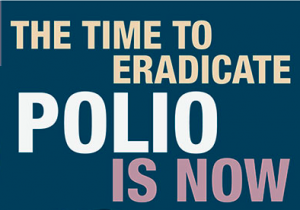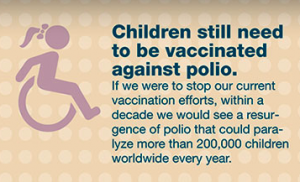Inactivated Polio Vaccine (IPV)
You may think polio is a disease of the past, and here in America, it sort of is. However, without the polio vaccine, America could easily see polio again.
Polio was once the leading cause of disability in the United States. It was also considered one of the most dreaded of the childhood diseases. During the mid twentieth century there were more than 25,000 cases of polio reported each year.3 (And probably a high number of unreported cases, as well.)
The polio vaccine was introduced in the U.S. in 1955 and by 1960, the number of reported cases had dropped to about 3,000 and in 1979 to about 10 cases.3
Today polio is considered eradicated in the United States. However, polio is still very common in some developing countries. And the effort for world-wide eradication of polio is still underway.
All it would take for polio to enter the United States is for an unvaccinated person to travel to a place where polio still exists. That person could easily carry polio back into the U.S. and begin to infect unvaccinated individuals. And those people would infect more people, and so on. This has happened several times in the past fifty years since eradication, but thankfully the cases remained isolated due to the high numbers of vaccinated individuals.
But, polio could easily make a come back, so don’t believe that if you or your children are not vaccinated that they are safe. Just because we don’t see the disease every day doesn’t mean that it doesn’t exist and that we shouldn’t protect ourselves and our children.
So what’s so bad about polio, anyway?
Poliomyelitis (polio) is a highly infectious disease that is caused by an enterovirus. The virus invades the nervous system and lives in the throat and intestinal tract of those who are infected.
The virus spreads from person to person via infected stool or oral/nasal secretions from the infected individual entering the body of a non-infected individual through the mouth.
Polio often does not cause serious illness, and many times people infected with polio display no symptoms of the disease. In fact, about 72% of those infected will have no symptoms.2
About 24% of people infected with polio will develop minor symptoms including: Fever, fatigue, nausea, headache, flu-like symptoms, and/or pain in the limbs.2 All of the symptoms tend to resolve completely.
But, here’s why you should care:
In about 1% of those infected, polio may cause paralysis—inability to move arms and legs (most often the legs). It also can cause permanent disability, meningitis, and even death due to the paralization of muscles that help the body breathe. For those who develop paralysis, about 5-10% die due to paralysis of the respiratory muscles.2 This death rate increases with age.
When polio was common in the U.S., it paralyzed and killed thousands of people every year.3
Unfortunately there is no cure for polio, so if you or your children get sick with polio, you are taking your chances. Getting vaccinated is the best way to keep yourself and your family safe from polio.
Let’s discuss the vaccine:
There are two types of polio vaccines: the inactivated polio vaccine (IPV) and the oral polio vaccine (OPV). OPV is made from the live poliovirus. It is considered to be highly effective at preventing polio disease, however a few cases a year of polio were seen, caused by the vaccine itself. The IPV is made using an inactivated (dead) virus, which is unable to cause polio.
The oral version of the vaccine has not been used in the United States since 2000, however it is still used throughout a lot of the world. The IPV is the only polio vaccine given in the U.S. It is given as an injection in the arm or leg, depending on the patient’s age—in the leg for most children.
Nowadays, most everyone gets the polio vaccine during childhood. It is recommended that children get four doses of IPV: One at 2 months, one at 4 months, one between 6 and 18 months, and finally a booster between 4 and 6 years of age.
It is safe for IPV to be given at the same time as other vaccines, and it often is given along with other vaccines, as recommended in the childhood vaccine schedule.1
If you were given all of the recommended vaccines as a child, then you shouldn’t need another polio vaccine unless:
- You are traveling to a polio-endemic or high-risk area of the world (see bottom of post for endemic regions).
- You work in a lab handling specimens that might contain polioviruses.
- Or you are a health care workers who have close contact with a person who could be infected with the poliovirus.
Adults that fall into these increased risk groups and who have been fully vaccinated against polio can receive one lifetime polio booster of IPV and be considered protected.
If you have never been vaccinated against polio, you should consider getting three doses of IPV. The first dose may be given at any time. The second will be given 1-2 months later, and the third will be given 6-12 months after the second dose.
If you have had several doses of the polio vaccine, but are not fully vaccinated, it is important to get the booster doses. It doesn’t matter how long it’s been since your last dose.
There are several reasons why you should not get the polio vaccine:
- If you have had a serious reaction to a previous dose of the polio vaccine, you should not get the remaining doses. If you have had a severe reaction to the antibiotics streptomycin, polymyxin B, or neomycin, you should not get the vaccine.
- If you are moderately ill at the time the vaccine is scheduled to be given, wait until recovered to get the vaccine.
- Pregnant women should avoid the vaccine, however there have been no reported side effects in pregnant women who have received the vaccine.
What are the risks and side effects with getting IPV?
Just like with many vaccines, people who get IPV may have redness and/or soreness at the injection site. This is perfectly normal. The vast majority of people do not have problems with the vaccine. The risk that IPV could cause serious harm to your child is extremely small.1
However, this vaccine, like any medicine, has the potential to cause severe allergic reaction. If you think you or your child is having, has had a serious reaction to a vaccine, click here for more information on what to do and how to report the issue.
Because this vaccine is so effective, it is entirely possible to ERADICATE POLIO FROM THE ENTIRE WORLD.
The World Health Organization (WHO) launched the Global Global Polio Eradication Initiative (GPEI) in 1988, headed by national governments, the CDC, Rotary International, WHO, and UNICEF, with substantial support from the Bill & Melinda Gates Foundation.2
Currently the countries where polio is endemic are Afghanistan, Nigeria, and Pakistan. It also continues to get re-introduced into what’s called the “poliovirus importation belt”, which include countries from west Africa to the Horn of Africa, Cameroon, and Syria.2,5
Until polio is eradicated in all of the World’s countries, the risk of polio transmission still remains. The hope is that someday polio will be completely eradicated from the world. And it’s completely possible due to the fact that polio only lives in humans (can’t hide out in animals), and because we have such a highly effective vaccine. But, until then, it’s very important that we keep getting our children vaccinated.
All of us are responsible for the elimination of this terrible disease. Do your part. Get your family vaccinated and keep polio from having anywhere to hide.
For more on global polio eradication, check out the Polio Global Eradication Initiative at www.polioeradication.org
Very interesting polio-related links:
- On this Day: Polio Vaccine Introduced to British Public in Bid to Eradicate 20th Century Plague
- Polio Children.org (Children living with polio-related disabilities)
- “Rotarians Make Fight Against Polio Their Own.” The rotarian Magazine
Resources:
- WebMD. www.webmd.com
- Centers for Disease Control and Prevention. www.cdc.gov
- Immunize.org
- vaccines.gov
- Polio Global Eradication Initiative. www.polioeradication.org
Photos courtesy of a CDC infographic.






